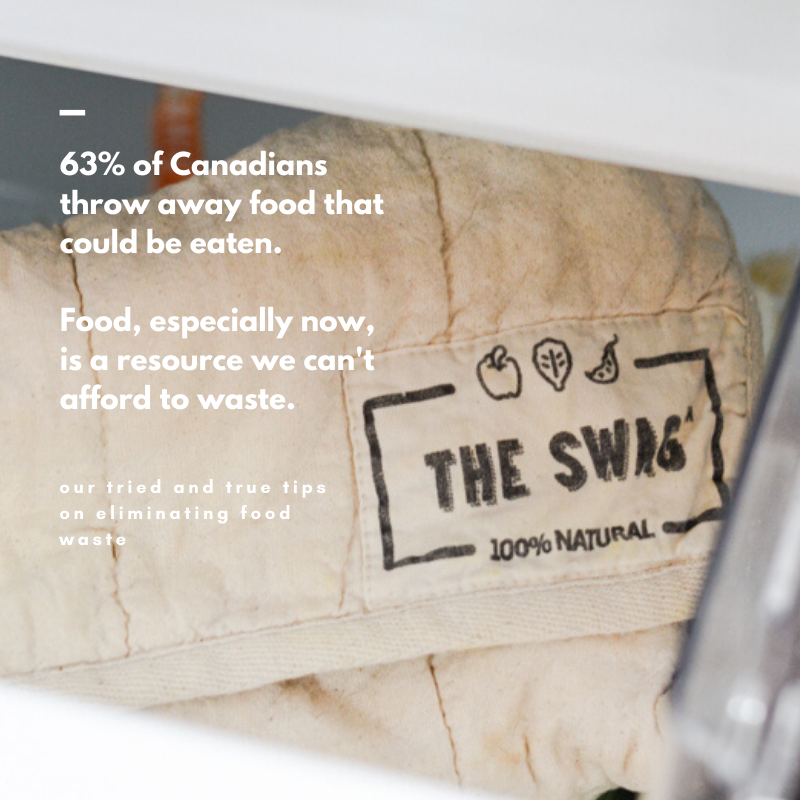Eliminate Food Waste Forever!!


one.
Organize Your Fridge: Not the sexiest advice, we know, but unless you know what you have and can clearly see it, food will get wasted (I mean, how many times have you discovered that rogue little dish in the back that's WAY beyond saving?).
Make a spot for everything. A shelf for leftovers that are clearly labeled (stack them with the oldest items in the front so they get used first).
Store high ethylene producers (ripening gas released by fruit/veg) seperately in the low humidity drawer (often this is labeled the 'fruit' drawer). Common examples are apples, pears, grapes, melon, mushrooms, tomatoes, oranges and lemons.

two.
Work from the basics. Usually (except during market season) we keep more or less the same foods in our fridge. This strategy means we have lots of experience cooking with certain foods, and it makes taking inventory and doing a grocery shop expedient. We really explore the diversity of each vegetable or raw ingredient so that we can prepare it many different ways. Of course our line-up changes seasonally.

three.
Some vegetables and fruit have a much shorter fridge-life than others. Use the most delicate stuff first and save hardier vegetables for later. For example, use lettuce first, then kale then cabbage for salads. Or use peppers and zucchini first then move on to carrots, sweet potato and cauliflower. You get the idea.

four.
Leverage food savers. No exaggeration, used properly, our favourite food savers extend the life of some veg 2 - 3 times as long. (We've kept cilantro -- notorious for going off quickly -- alive in the fridge for two weeks!) Here are our favourites:
The Swag - this bag is a little miracle. Wet the bag and insert veg. Roll it up and pop it in the fridge. Keep the bag moist and be amazed at how LONG your produce lasts! Perfectly fresh and edible veg two weeks later!!
Abeego Beeswax Wraps - Abeego wraps seal and conserve freshness without trapping moisture, they help your food stay fresh for longer, preventing molding, which means healthier, more nutrient-dense and better-tasting food, plus more days to eat every morsel. We like to use flat wraps like our Abeego's for bowl covers or two wrap around cut fruit like avocados or lemons.
BeeBagz - like wax wraps, but sewn into a bag!! These level up the convenience factor as all you have to do in crimp down the top to preserve your food. Our favourite is the large bag, which we use in particular to store greens like kale, lettuce, herbs, as well as things such as celery, and chopped up cauliflower/broccoli.

five.
Best Before Dates are super confusing. They lead consumers to believe that food is at risk of causing food poisoning after the date has passed, when in reality the best before date refers only to food quality - flavour, freshness, etc. Most foods are still fine to eat 7-10 days AFTER the best before date has passed.

six.
Keeping a stocked pantry helps to minimize waste because a simple meal is always close at hand. By keeping healthy, whole-foods like beans, legumes, or grains always on the shelf, you can easily make a meal using last-chance fresh ingredients.

seven.
It's not hard to make a case for leftovers (whatever you thought of them as a child, as a mom they are the BEST!). We tend to re-imagine leftovers for the sake of variety - for example, last night's bean burgers become today's lunch crumbled over dressed kale and topped with a fried egg. We also tend to make large batches of soups and stews that can be eaten and enjoyed for many days at a time. Just don't forget to clearly label AND organize them in the fridge. If you know you won't get to eating them for several days freezing is a good option too.

eight.
Most of the time, limp veggies (even leafy greens like kale), can be restored by immersing them in super cold water for 30 minutes or so. It works like a charm!
Note: Most often it is not recommended to wash veggies until you're ready to use. However we find that washing veg/greens right away, and then immersing in a cold water bath for 10 or so minutes, then allowing to slightly dry before placing in a Swag or BeeBagz in the fridge works incredibly well for long-lasting food.

nine.
Oftentimes it's tempting to start with a recipe idea only to realize you don't have the ingredients, which normally (maybe not in Covid times) would result in buying more food instead of using what you have. Instead, take a look in the fridge and begin your meal planning with what most needs using up. For example, leftover turkey becomes turkey stew. If you need inspiration, check out Yummly, which allows you to search for recipes based on ingredients.

ten.
Sometimes waste... isn't waste! Our favourite example of this is saving veg peelings and scraps to make stock (and chicken/beef bones if you aren't vegetarian). Make sure you thoroughly wash all your veggies, and then save things like celery roots/leaves, onion ends/peels, carrot peelings, parsley stems, kale stems... really anything you can think of. Toss it into a bag and store in the freezer - when the bag is full, toss it in a pot (along with bones if using) and add an extra onion, a carrot or two, and a few stalks of celery. Add a tsp or so of coriander seeds and a few peppercorns, cover with water and you're all set (we love our Instant Pot for this task). Other examples of things to rescue: pickle juice (makes great flavouring), stale bread for croutons, whey (for fermenting)...

eleven.
Certain meals lend themselves very well to using up various bits of what we call "last chance" fresh food (they are a day or two away from the compost). In our experience omelets, pasta dishes, soups, and homemade pizza are all great ways to use it up! You could also toss it all into some brine and ferment it to extend the life (the photo shown is an example of that and includes cabbage, beets, kale and celery that weren't doing so hot). You could also cut up and freeze (some things might need to be parcooked first, like potatoes). If you tend to store a lot of things in the freezer -- a space that tends to be notoriously unorganized and jam packed -- we suggest hanging a clipboard with a chart that lists the freezer contents (and the date stored) so you can easily see what you have. Just remember to cross out the item you remove to keep your list current!



